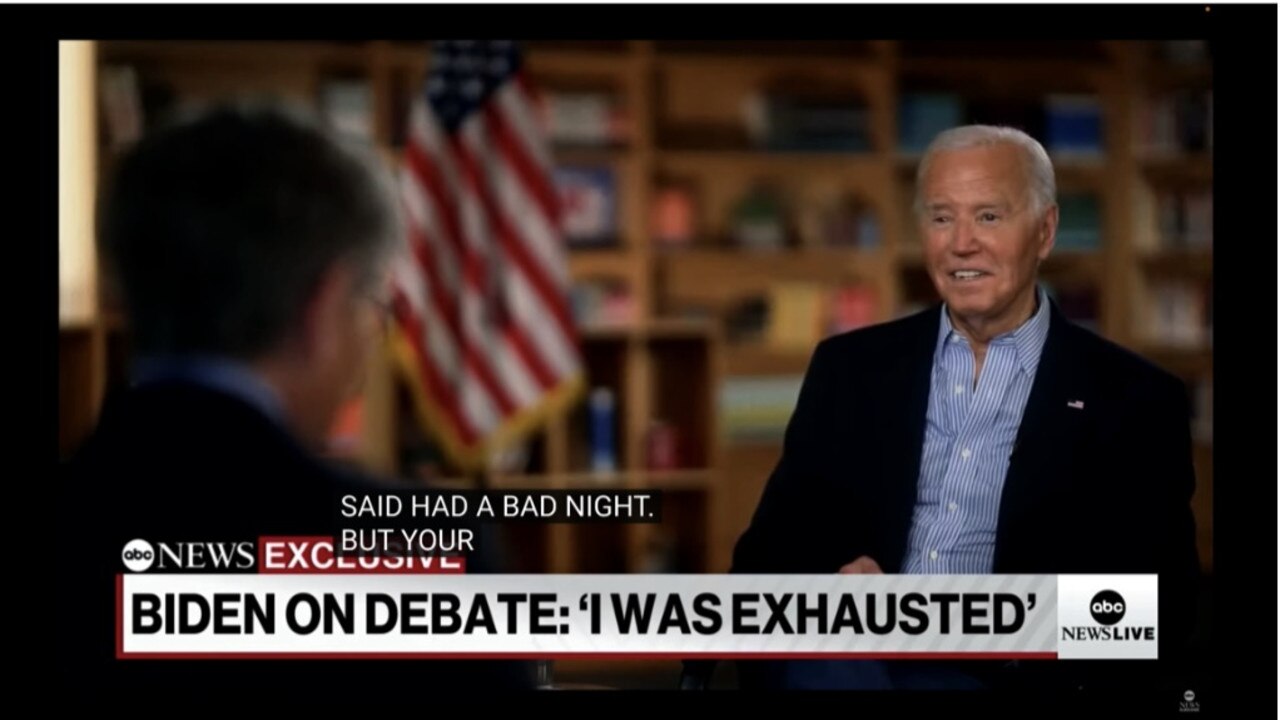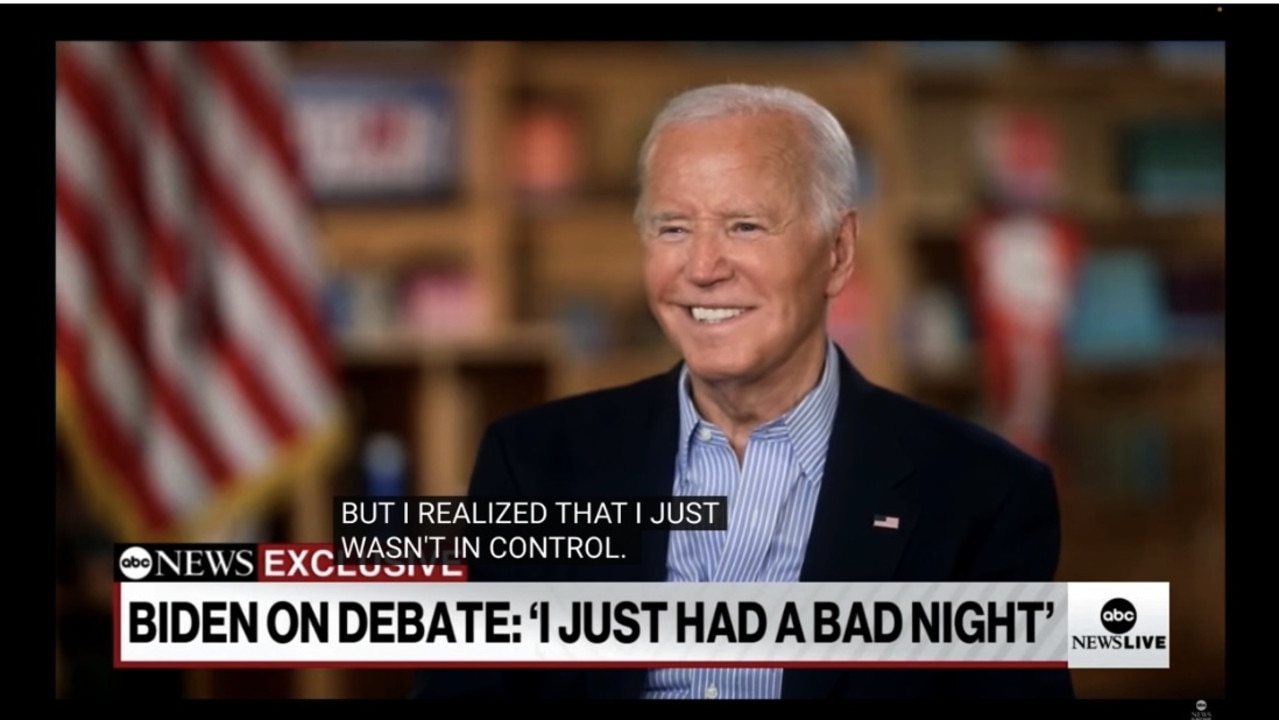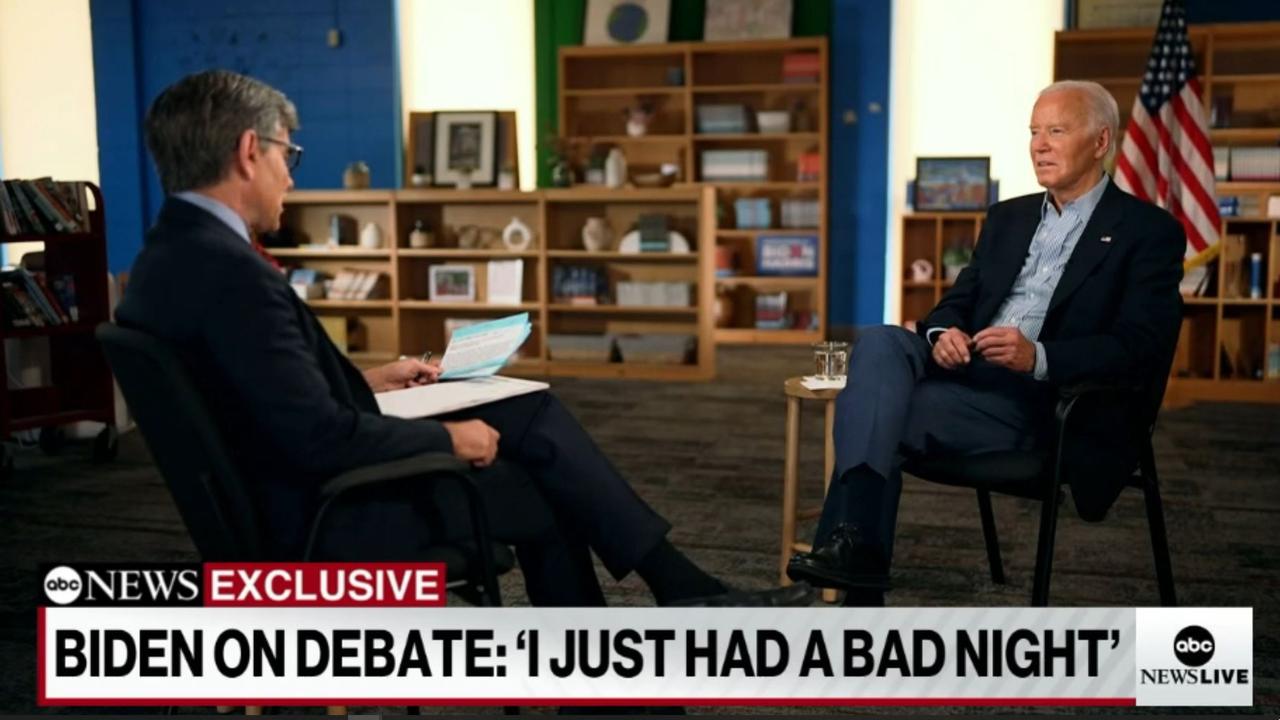Body language expert explains how Joe Biden fails to alleviate fears about his health
For Joe Biden to win the US election and overcome fears around his cognitive health, he must address his non-verbal response to stress. Body language expert Katia Loisel explains some moments he showed this.
This was a man who knew that he’d fallen out of favour with the American public.
While he had animated expressions, a rehearsed narrative and key points, a tanned complexion, his shirt open and frame accentuated with shoulder pads as perhaps a strategic attempt to paint a picture of health, vitality, and competence to win back public approval — it may have been too little, too late.
For Biden to win this Presidential race and alleviate fears around his cognitive health, he needs to address his non-verbal response to stress.
In particular, his speech disfluency, a slack jaw with a gaping mouth, and a blank expression in which eyes seemingly stare out are all associated with the stress and fear response. That doesn’t bode well for Biden.
From the opening question, Biden’s facial expressions were notably more animated and expressive, perhaps in response to criticism he received about his deadpan appearance during the Presidential debate.
However, the duration, symmetry, synchronisation and profile of his smile, with an often sudden rather than smooth onset and offset and fixed, unnaturally long duration, suggests a forced rather than a genuine smile.
In response to “You and your team said you had a bad night,” Biden’s fixed smile dropped suddenly, his lips temporarily downturned, before elongating into a forced smile.
However, while this is a submissive gesture that says, ‘All is well,’ and ‘You can trust me,’ Biden’s raised eyebrows were a non-verbal show of innocence and request for approval.

His hands were resting in his lap, fingers curled around a pen in an attempt to self-soothe.
He had pronounced thoracic breathing, fast and shallow breathing through the upper chest, and swallow that indicate fight or flight and a level of emotional discomfort.
Activation of the sympathetic system during fight or flight can decrease salivation as resources are directed away from the digestive system.
This can result in a dry mouth and an attempt to lubricate through swallowing. Moreover, the volume drop during Biden’s response may indicate a verbal retreat in an attempt to distance himself from what he is saying.

It’s important to interpret Biden’s smile in the context of his baseline and other contextual factors. His smile, which is often asymstmetrical, with the right lip often more elevated than the left, may also be mistaken as contempt.
However, his facial expressions tend to be asymmetrical, with the right side of his face often appearing more expressive than the left.
While asymmetry and a lack of synchronisation in facial expressions can indicate feigned rather than felt emotions, several other factors, including facial paralysis, nerve damage, cosmetic surgery and dental issues can affect the amount of movement and the symmetry, synchronisation and profile of facial expressions.

The second part of the opening double-barrelled opening question set the tone for the interview.
Quoting Nancy Pelosi and evoking the ‘voice of the people’ enabled Stephanopoulos to confront Biden with a critical question while retaining an air of neutrality.
As Stephanopoulos asked, “Your friend Nancy Pelosi actually framed the question that I think is on the minds of millions of Americans. Was this a bad episode or a sign of a more serious condition?” and we noticed a marked non-verbal shift in Biden.
His forced smile dropped, his lips downturned in a partial display of sadness, his gaze became unfocused as if staring, his breathing rate increased, and his mouth gaped open.
It’s important to note that several factors, including a subconscious attempt to increase airflow and oxygenation during fight or flight, may cause a slack jaw and gaping open mouth, as evident throughout the Presidential debate and this interview.

These non-verbal shifts were evident throughout the debate, with Biden non-verbally bracing himself during each question, and in particular those relating to the debate, his health and corners over his presidency.
He was in the firing line and he knew it.
When asked, “Did you ever watch the debate afterwards?” Biden responded with a qualifier, “I don’t think I did, no” which is an unusual response to a direct question.
There’s a distinct pattern of behaviour evident throughout this interview, with marked differences in Biden’s communication when bracing himself in anticipation of or responding to a question or delivering a rehearsed message, often after he had avoided the question and shifted the narrative.
For instance, in response to “What were you experiencing when you were watching the debate? Did you know how badly it was going?”, Biden’s prolonged eye block and pause and increased blink rate suggest an increase in emotional and cognitive load and an attempt to distance himself from the question.

Prolonged pauses can also enable us to buy time and regain our composure, as was evident by the narrative and postural shift that followed.
While Biden’s heightened blink rate suggested high cognitive load as he thought his way out of it, he straightened up, and his more relaxed, animated delivery and use of symmetrical illustrators suggested a man who was back on message.
It’s interesting to note a non-verbal slip during this response. When discussing the Presidential debate and Trump, Biden said, “He also lied 28 times.”
While the use of also may have been as an additional thought, it may have been a verbal slip and an opportunity to probe further to get to the truth.

Biden’s smile with an unnatural onset, offset and synchrony in response to the comment is an example of what is known as an inappropriate concern, a distancing behaviour that may be used to distance himself from the comment.
Much like Trump’s forced clown-like grimace, Biden’s forced smile acts as a mask, a behavioural countermeasure used to deflect and conceal what he’s feeling, control non-verbal leakage and regulate the psychological response to stress.

However, Biden’s mask soon dropped in response to the following: “People who spent time with President Biden over the last few months or so said that the lapses appeared to be more frequent, more pronounced.” His downturned lips were reliable indicators of sadness. Biden’s increased breathing rate, his visible thoracic breathing short and fast, at times appearing to gasp for air, and increased digital flexion, his fingers grasping and tightening around the pen, are additional indicators of negative arousal and stress.

GEAR SHIFT
In response to the question, “Are you the same man today that you were when you took office three and a half years ago?” we see a marked nonverbal shift as Biden switches gears.
He begins the response with the qualifier, “In terms of successes, yes”, before launching into his accomplishments, his animated facial expressions, increased vocal range and volume, and use of illustrators suggest a level of congruence and confidence with what he is saying.
From an impression management perspective, the use of repetition, with Biden repeating “I was also the guy” three times, suggests a convincing tactic used to emphasise his point, persuade viewers and create alignment with his point of view.
This pattern of advance and retreat behaviour is evident throughout the debate.
As Biden said, “One thing I’m proudest of, remember when my economic plan was put forward?” he leant in, orienting his body towards Stephanopoulos to draw the audience in and emphasise his point. However, when Biden loses his train of thought or an increase in disfluency or speech errors, we often see a postural retreat and increased blink rate, suggesting heightened emotional arousal. This gestural retreat may be an attempt to distance himself from an unwanted thought, what he is about to say or an uncomfortable situation.
Our brains give a disproportional amount of attention to hands and are prewired to interpret gestures and illustrators, and for good reason. Using illustrators to emphasise or illustrate what we’re saying helps us to think and speak more clearly and allows others to better understand and remember our message.
Using open-palmed gestures with your heart window open also conveys sincerity and honesty, essentially saying, ‘You can trust me,’ but when emotional or cognitive load increases when we’re feeling anxious, scared, overwhelmed or lying, our use of illustrators can decrease, and our hands often disappear or retreat.

We see this postural shift when Biden says, “It’s about the character of the President.” Leaning in, his asymmetrical open-palmed gesture emphasises his point and indicates a sense of confidence, competence, and conviction.
Katia Loisel is a Connection, Behaviour and Body Language Specialist and Coach at katialoisel.com
More Coverage
Originally published as Body language expert explains how Joe Biden fails to alleviate fears about his health




